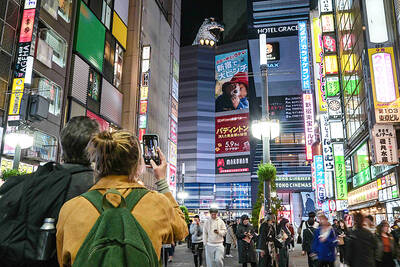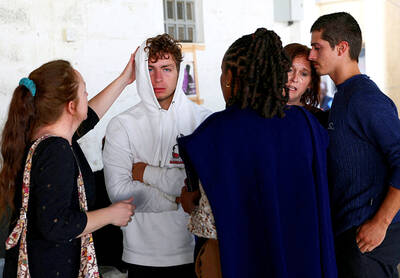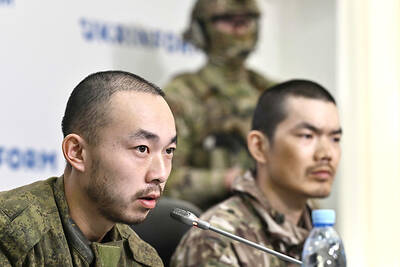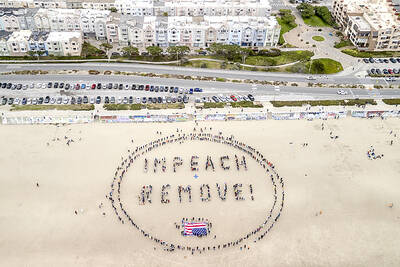"No women, no beer, no fiesta," a Peruvian mercenary said gloomily as he manned his post inside the Iraqi capital's ultra-protected Green Zone.
Around a thousand of his countrymen along with a handful of Chileans make up a security detail in this immense fortified sector of Baghdad, which houses the Iraqi government's offices and the US and British embassies.
The South Americans comprise a "third rung" of security, behind Iraqi regular soldiers and a unit of Georgians, members of the US-led coalition forces from the former Soviet republic.
The Peruvians are employed by the private US security firm Triple Canopy based in Virginia.
About a year ago, the Peruvians replaced the famed Nepalese Gurkhas who had served in the British army, but not because the South Americans were judged more competent. They replaced the Nepalese because they were cheaper.
A Western private security operative from a modern army -- such as an American, a Briton or a South African -- can earn US$8,000 to US$16,000 per month, one private security official said. The Gurkhas were earning around US$3,000 per month. The Peruvians earn about one-third of that.
Other firms employ Colombians, Mexicans or Panamanians. The South Americans, who are all former soldiers aged between 25 and 40, mostly come from poor, rural areas. Their missions last one year, with a break after six months for home leave.
In their position as the third line of defense, the Peruvians are not typically exposed to grave danger. Most have never left the Green Zone and some ask: "What's the Red Zone like?" in reference to the rest of Iraq.
Indeed, their primary enemy is the heat, as most are posted in exposed guard posts. Boredom is their other key enemy.
"There is nothing to do here," one man said.
"We watch television," said another. "But we'd like to be able to go out a bit at night."

Young women standing idly around a park in Tokyo’s west suggest that a giant statue of Godzilla is not the only attraction for a record number of foreign tourists. Their faces lit by the cold glow of their phones, the women lining Okubo Park are evidence that sex tourism has developed as a dark flipside to the bustling Kabukicho nightlife district. Increasing numbers of foreign men are flocking to the area after seeing videos on social media. One of the women said that the area near Kabukicho, where Godzilla rumbles and belches smoke atop a cinema, has become a “real

Two Belgian teenagers on Tuesday were charged with wildlife piracy after they were found with thousands of ants packed in test tubes in what Kenyan authorities said was part of a trend in trafficking smaller and lesser-known species. Lornoy David and Seppe Lodewijckx, two 19-year-olds who were arrested on April 5 with 5,000 ants at a guest house, appeared distraught during their appearance before a magistrate in Nairobi and were comforted in the courtroom by relatives. They told the magistrate that they were collecting the ants for fun and did not know that it was illegal. In a separate criminal case, Kenyan Dennis

APPORTIONING BLAME: The US president said that there were ‘millions of people dead because of three people’ — Vladimir Putin, Joe Biden and Volodymyr Zelenskiy US President Donald Trump on Monday resumed his attempts to blame Ukrainian President Volodymyr Zelenskiy for Russia’s invasion, falsely accusing him of responsibility for “millions” of deaths. Trump — who had a blazing public row in the Oval Office with Zelenskiy six weeks ago — said the Ukranian shared the blame with Russian President Vladimir Putin, who ordered the February 2022 invasion, and then-US president Joe Biden. Trump told reporters that there were “millions of people dead because of three people.” “Let’s say Putin No. 1, but let’s say Biden, who had no idea what the hell he was doing, No. 2, and

DEMONSTRATIONS: A protester said although she would normally sit back and wait for the next election, she cannot do it this time, adding that ‘we’ve lost too much already’ Thousands of protesters rallied on Saturday in New York, Washington and other cities across the US for a second major round of demonstrations against US President Donald Trump and his hard-line policies. In New York, people gathered outside the city’s main library carrying signs targeting the US president with slogans such as: “No Kings in America” and “Resist Tyranny.” Many took aim at Trump’s deportations of undocumented migrants, chanting: “No ICE [Immigration and Customs Enforcement], no fear, immigrants are welcome here.” In Washington, protesters voiced concern that Trump was threatening long-respected constitutional norms, including the right to due process. The